Test Rigs
The Turbomachinery Laboratory
at Texas A&M University is a 35k ft2 research facility dedicated
to conduct research in turbomachinery performance and reliability. The
Laboratory, located 1.5 miles away from main Campus, is known world-wide as the
most advanced of its class, with multi-million dollar facilities supported by
the oldest university-industry consortium in the US (TAMU Turbomachinery
Research Consortium) and revenue from the International Turbomachinery
Symposium and International Pump Symposium. The annual Symposia, the largest in
the world, are continuing education events attracting thousands of engineers,
vendors and suppliers of rotating machinery.
Facilities
at The Turbomachinery Laboratory
The Laboratory contains 12 test cells, three of which are dedicated
to research high-speed seal and bearing technologies (129, 134 & 140). Each
test cell is a 20' x 25' x 12' air conditioned space with a separate control room,
20' x 25'. Each test cell has acoustical isolation walls and ceiling; a sealed
concrete floor with isolation slabs; one 480V 400A buss bar electric power
supporting the following circuits: five 120V (30A), four 208V (20A), two 208V (50A)
single and three-phase. Each cell can be supplied with 30 gallon/minute water
supply; 4" floor drain with oil separator. The whole laboratory has a
fireproof water sprinkler system, flame retardant floors and walls, etc.
Laboratory compressor facilities deliver dry and oil-free pressurized
air: (a) 4" at 300 psi and 1350 cfm, (b) 4" at 125 psi and 1800 cfm,
and (c) 3" 2,375 psi.
The laboratory 40' x 125' x 25' air conditioned high bay is
equipped with a 20-ton overhead crane. The Laboratory also includes a fully
equipped machine shop, a welding shop, a sheet metal fabrication shop, an electronics
repair facility, and a woodworking shop.

Test
rigs for High Speed Bearings and Seals
The TurboLab hosts the Rotordynamics Laboratory in three test cells
that accommodate a number of test rigs for the experimental validation of the
dynamic response of fluid film bearing and seal (liquid and gas) elements used
in high performance turbomachinery, including micro turbomachinery (MTM).
Test rig for static and
dynamic performance of radial gas foil bearings

Unique test facility to measure the static and dynamic load
performance of gas (oil-free) bearings for advanced turbochargers, micro
turbines and fuel cells as applied to microturbomachinery.
The test rig design allows the easy installation and dismantling of
test bearings, 35 mm OD. The rig consists of a ball-bearing T25 turbocharger
modified by replacing the compressor wheel with a test bearing section. The
maximum shaft speed is 75 krpm (cold air supply).
Two 100 N (20 lbf) electromagnetic
shakers apply dynamic load excitations to 600 Hz on the bearing and an ad-hoc
mechanism applies static loads on the test bearing mounted atop a precise
positioning electronic system.
The instrumentation includes eddy current sensors, load cells and
accelerometers to delver the test system frequency
response and identification of force coefficients over a frequency range.
Facility used to measure (for the first time) the force
coefficients of metal mesh foil bearings, shimmer bump-type foil bearings, as
well as to quantify the effect of coatings on foil bearing performance.
Test rig for static and
dynamic performance of thrust gas foil bearings
To measure the static and dynamic performance of oil-free
turbochargers, micro turbines and fuel cells. The test rig con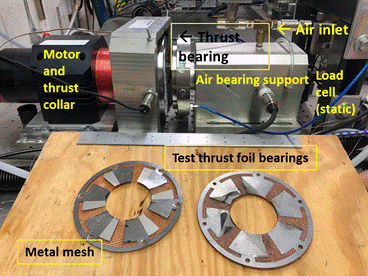
sists
of a solid steel thrust collar spun by a 2.2 kW router motor (40 krpm max), a rotor collar (101 mm OD), and a test bearing
attached to a thrust load shaft. An aerostatic plenum contains two porous
carbon bushings on which the load shaft floats, and when pressurized, pushes on
the shaft to produce a load on the test bearing (580 N max). A torquemeter and shaker attach on one end of the load shaft.
The shaker delives dynamic loads (max. 100 N) to
excite the test bearing axial displacements. Axial stiffness and damping
coefficients are extracted from force/displacement frequency response functions
obtained from excitations over a frequency rage. A separate cooling systems
through the center of the load shaft assists on the thermal management of the
test bearing.
Test rig for evaluation of
radial gas foil bearings operating at high temperature
Built with funds from NASA Glenn RC, the facility allows the evaluation
of radial foil bearings operating at high temperature (300C). A 10 kW motor
drives a rotor supported on gas foil bearings, and an electric cartridge heater
increases the temperature of the hollow test rotor.
Measurements include rotor displacements using optical and infrared
sensors and temperatures in the bearing cartridges. The rotor imbalance
response to 50 krpm reveals the test system response,
linear and nonlinear, with a parameter estimation to deliver the bearings’
effective stiffness and damping coefficients.
Tests conducted to evaluate survivability of high temperature
coatings for foil bearings as well as shimmed foil bearings for MTM.
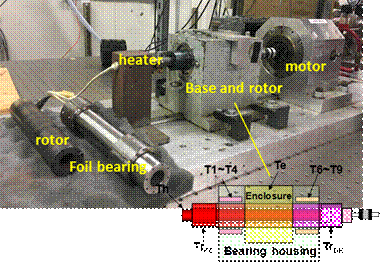
Test rig for dynamic response
of rotor-motor supported on gas bearings
Built with NSF funds, the facility quantifies the response of gas
bearings, flexure pivot type and porous type. An AC high frequency motor
integral to the rotor with speed of 100 krpm. A pair
of bearings support the test rotor (29 mm OD) to conduct tests recording the
imbalance response due to a number of external excitations including road
conditions (intermittent impacts) as well as base support (IC engine
excitations) at low frequencies.
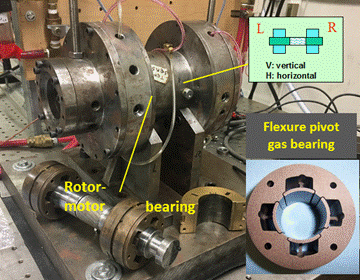
Test rig for static and
dynamic performance of lubricated high speed bearings and seals
State of the art industrial facility with
years of service to the turbomachinery industry. Sponsors (users) include
various compressor manufacturers and bearing / seal makers.
Air turbine (50 kW) drives a rigid rotor
supported on ball bearings. Test bearing/seal element flexibly supported at
rotor middle span and connected to two shakers with maximum dynamic load of
1,000 lbf @ 320 Hz and a hydraulic static loader with
maximum load of 10,000 lbf (specific load=350 psi).
Rotor top surface speed is 80 m/s at 16 krpm.
Instrumentation includes an in-line torquemeter,
sensors for rotor displacement, and bearing accelerations and loads, and
flowmeters. Bearings instrumented with up to 40 thermocouples. Operation of
test rig automated with various control systems.
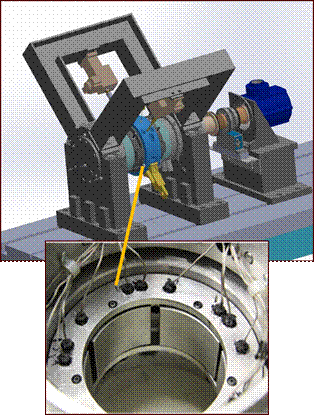
Test rig for static and
dynamic performance of gas seals for advanced turbomachinery
Test rig to measure the performance of gas labyrinth seals for
steam turbines and compressors.
A variable frequency drive motor turns a heavy shaft (250 lbf) that is supported on magnetic bearings. These bearings
also serve to excite dynamically the rotor to whirl inside the seal test
section. The housing and tests seals are split in two for easy assembly of
interlocking labyrinth seals. The rig architecture takes advantage of additive
manufacturing to produce inlet swirl vanes, swirl brakes and exit labyrinth
seals. The rotor 150 mm in diameter at the seal section spins to a top speed of
10 krpm (surface speed of 80 m/s). Pressurized air to
300 psi and a controlled exit pressure determine the test conditions for
measurement of seal leakage and pressure cavities, static and dynamic. Sponsors include steam turbine manufactures.
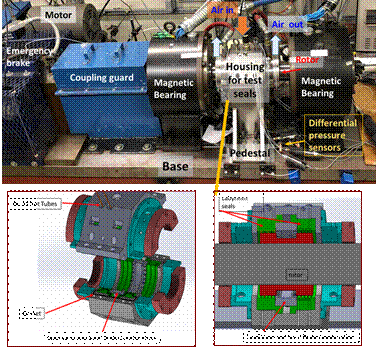
Test rig for dynamic
performance of advanced squeeze film dampers for aircraft engines
Test rig to measure the dynamic forced performance of advanced
squeeze film dampers used in aircraft engines, commercial and military. A major
jet engine manufacturer funded the test program during ten years to produce
ultra-short dampers with unsurpassed energy dissipation characteristics. This research facility is top in the world.
The test rig comprises a massive bearing cartridge (BC) supported
on four elastic rods that provide a centering stiffness. The journal is solid
and affixed to a heavy table. Two orthogonally positioned shakers and stingers
connect to the BC and deliver excitation forces (max. 500 lbf).
Engineered squeeze film damper sections are tested under a myriad of operating
conditions. Measurements include film dynamic pressures, and applied forces and
displacements for identification of damping and inertia force coefficients over
large frequency ranges (to 200 Hz).
The facility continues to produce test results for high frequency
operation with natural air ingestion that degrades the performance of dampers
and also while operating under severe
maneuver loads and high altitude conditions.
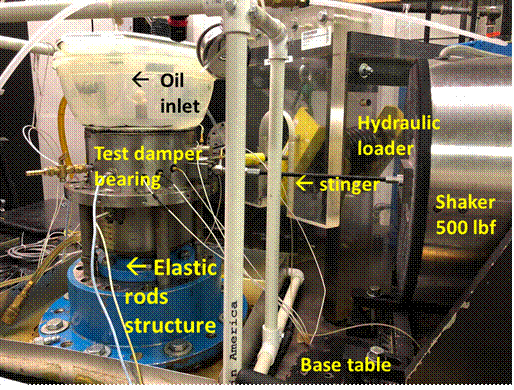
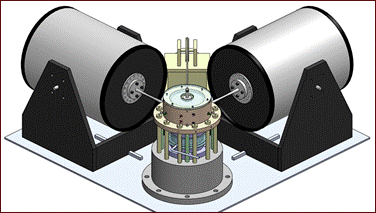
Computational facilities
A cluster of high speed networked PCs to conduct CFD analyses for
turbomachinery components
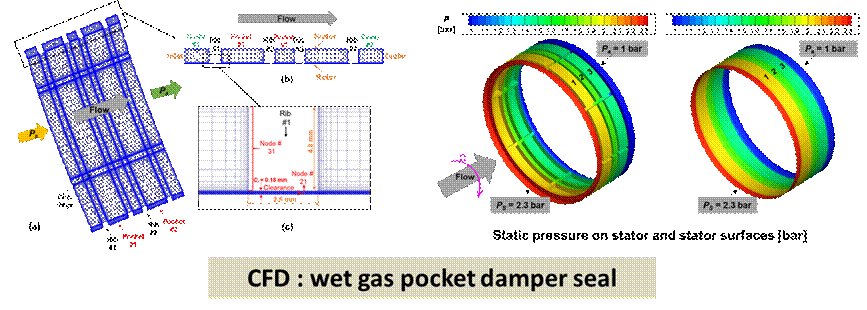

Instrumentation
Shakers: Hydraulic: two 1,00 lbf, 500 Hz max; electromagnetic: two 500 lbf, 500
Hz max; two 100 lbf x 1 kHz, two 20 lbf x 2 kHz, one 5 lbf
x 2 kHz.
Seven calibrated impact guns and hammers – forces ranging from 1 lbf to 1,000 lbf)
Multiple DAQ system and including Bentley Nevada ADRE® systems – 2
x eight channel DAQs for measurement of rotating machinery vibration (max 60 krpm)
Seven 16 channels NI® DAQ boards with customized
LABview® for data acquisition, reduction, and tests
control. (max rotor speed 200 krpm).
Two two-channel Agilent 3567A spectrum analyzers.
Dozens of accelerometers, eddy current sensors, velocimeters,
tachometers, etc
Dozens of multi meters and thermocouple temperature display meters.
Prepared by Luis San Andrés,
November 2, 2018
Other Test rigs fully instrumented and available for research in rotordynamics and fluid film bearings:
·
High temperature brush seals (leakage)
·
Water thrust hydrostatic and radial bearings for turbopumps (rotordynamic
response)
·
Carbon-graphite gas bearings – characterization of rotordynamic response
·
Test rig for evaluation of gas/wet seals for the subsea industry
|
TRC Metal
Mesh Foil Bearing Test Rig – 1.5 inch diameter bearings, max
speed 110 krpm. Orthogonal shakers applying loads
to estimate bearing rotordynamic force
coefficients. Capability to measure bearing drag torque with increasing
applied loads. |
|
TRC Squeeze
Film Damper Test Rig - Controlled orbit, variable offset, variable speed to 6,000
rpm, variable supply pressure to 150 psig and different end seal condition
for dampers of small L/D ratio. Instrumented for measurement of fluid film
pressures and controlled air/oil mixtures. |
|
NSF-TRC
Squeeze Film Damper Test Rig - 45 kg - three disk flexible rotor
supported on squeeze film dampers for measurements of imbalance response to
10,000 rpm. Capability to test different lubricants with temperatures to
150F, supply pressures to 50 psig and flows to 5 GPM. |
|
Gas Foil
Bearing Test Rig – 1.5 inch diameter bearings, max speed 45 krpm |
|
High Speed Air
Bearing Rig – 29 mm diameter bearings, max speed100 krpm |
|
Flexible
rotor supported on elliptical oil bearings – imbalance response measurements – 10 krpm max |
|
Brush Seal
Test rig – leakage measurements, identification of brush seal stiffness
and damping coefficients |
|
CCO
Squeeze Film Damper – Circular Centered Orbits to 6 krpm,
Flow visualization and measurement of dynamic film pressures and forces |
|
Floating
ring bearing rotor kit - For measurement of subsynchronous
whirl response of rotor supported in floating and semi-floating ring bearings |
|
Three Bently Nevada rotor kits for measurement of rotordynamic response of a rotor on (a) hydrodynamic
journal bearing, (b) flexure pivot tilting pad bearings, (c) squeeze film
dampers. |
Supporting electronic data analysis
equipment:
TWO National Instruments 8-channel DAQ Units and LABView®
programs
TWO Bently Nevada 6-channel Data
Acquisition Interface Unit and ADRE for Windows™.
PC 700™ ZONIC 6 channel Digital Signal Processing - Data
Acquisition System.
Two dual channel 35670A HP spectrum analyzers, One
single channel 3561A HP spectrum analyzer.
Six PCB calibrated impact hammer kits (0 to 10 kg hammers)
Two 100 lb electro magnetic
shakers, Two 20 lb electro
magnetic shakers, One 5 lb electro
magnetic shaker
14 analog oscilloscopes, and more than 25+ piezoelectric
accelerometers, 25+ piezoelectric pressure transducers, 40+ BN proximity probes,
4 velocity sensors, 10+ load cells, 5+ optical tachometers, etc.